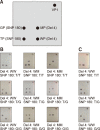Development of an oligonucleotide microarray for simultaneous detection of two canine MDR1 genotypes and association between genotypes and chemotherapy side effects
- PMID: 30481983
- PMCID: PMC6351760
- DOI: 10.4142/jvs.2019.20.1.27
Development of an oligonucleotide microarray for simultaneous detection of two canine MDR1 genotypes and association between genotypes and chemotherapy side effects
Abstract
Canine MDR1 gene mutations produce translated P-glycoprotein, an active drug efflux transporter, resulting in dysfunction or over-expression. The 4-base deletion at exon 4 of MDR1 at nucleotide position 230 (nt230[del4]) in exon 4 makes P-glycoprotein lose function, leading to drug accumulation and toxicity. The G allele of the c.-6-180T>G variation in intron 1 of MDR1 (single nucleotide polymorphism [SNP] 180) causes P-glycoprotein over-expression, making epileptic dogs resistant to phenobarbital treatment. Both of these mutations are reported to be common in collies. This study develops a more efficient method to detect these two mutations simultaneously, and clarifies the genotype association with the side effects of chemotherapy. Genotype distribution in Taiwan was also investigated. An oligonucleotide microarray was successfully developed for the detection of both genotypes and was applied to clinical samples. No 4-base deletion mutant allele was detected in dogs in Taiwan. However, the G allele variation of SNP 180 was spread across all dog breeds, not only in collies. The chemotherapy adverse effect percentages of the SNP 180 T/T, T/G, and G/G genotypes were 16.7%, 6.3%, and 0%, respectively. This study describes an efficient way for MDR1 gene mutation detection, clarifying genotype distribution, and the association with chemotherapy.
Keywords: Canine; Chemotherapy; MDR1 gene; Oligonucleotide microarray; P-glycoprotein.
Conflict of interest statement
Figures



References
-
- Alves L, Hülsmeyer V, Jaggy A, Fischer A, Leeb T, Drögemüller M. Polymorphisms in the ABCB1 gene in phenobarbital responsive and resistant idiopathic epileptic Border Collies. J Vet Intern Med. 2011;25:484–489. - PubMed
-
- Baars C, Leeb T, von Klopmann T, Tipold A, Potschka H. Allele-specific polymerase chain reaction diagnostic test for the functional MDR1 polymorphism in dogs. Vet J. 2008;177:394–397. - PubMed
-
- Bugde P, Biswas R, Merien F, Lu J, Liu DX, Chen M, Zhou S, Li Y. The therapeutic potential of targeting ABC transporters to combat multi-drug resistance. Expert Opin Ther Targets. 2017;21:511–530. - PubMed
MeSH terms
Substances
LinkOut - more resources
Full Text Sources
Medical
Miscellaneous

